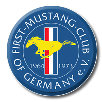Hi Oliver,
wenn du tatsächlich so`n Motor verbaut hast, kannste dich glücklich schätzen

Guckst du:
For 1968 only, a special high-performance version of the 302 was offered for the Shelby GT350.[7]
Its main features included an angled, high-rise aluminum or iron intake manifold, a larger Holley four-barrel carburetor, and bigger valves of 1.78 in (45 mm) intake and 1.6 in (41 mm) exhaust. It had a longer-duration camshaft, still with hydraulic lifters.
The heads had special close-tolerance pushrod holes to guide the pushrods without rail rocker arms or stamped steel guide plates. The combustion chambers also featured a smaller quench design for a higher compression ratio and enhanced flow characteristics. Additionally, high-flow cast exhaust manifolds similar to those on the 289 Hi-Po K-code engine further improved output.
Heavy-duty connecting rods with high-strength bolts and a nodular iron crankshaft were also included in this package. Rated power (SAE gross) was estimated at 315 hp (235 kW) at 6,000 rpm and 333 lb⋅ft (451 N⋅m) at 3,800 rpm.
The package, which cost $692 including some other equipment, was not popular and did not return for 1969. This engine was not a factory engine. Rather, like all Shelby Mustang engines, it was modified by Shelby American in their capacity as a vehicle upfitter. This special engine is well documented in the Ford factory engine repair manual for 1968 Mustangs and Fairlanes.
The block was made in Mexico. "Hecho en Mexico" casting marks are present in the lifter valley, and its main strength was the appearance of much larger and stronger two-bolt main bearing caps on the engine's bottom end - the same as the HiPo-289, but not made from nodular iron rather Ford's standard material. The Mexican 302 block was produced through to the mid-1990s and even showed up in Ford cars, trucks, and vans throughout the 1970s and early 1980s (Mexican-made 302 engines were often used by the USA car plants when CEP1 could not produce enough engines and many Ford replacement engines were Mexican). Mexican blocks were not made from a high-nickel content material as is generally thought, but rather Ford's usual ACB specification material. They are a good block but no stronger than any other USA-made component and the bore service life is generally lower due to less wear-resistant South American-sourced iron ore. All Mexican V8 blocks were cast and machined to accept a front engine mount as required for their truck applications.( Ouelle Wikipedia)
Statt 250 PS wird aber von fetten 315 PS geschrieben!
Gruß und


